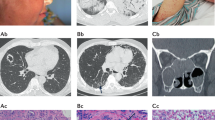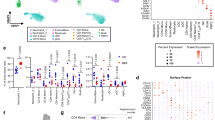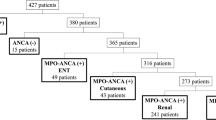Abstract
Wegener granulomatosis (WG), microscopic polyangiitis (MP), and Churg-Strauss syndrome (CSS) are characterized by the presence of anti-neutrophil cytoplasmic antibodies (ANCA). Anti-myeloperoxidase (MPO)-ANCA are a typical feature of MP and CSS, while anti-proteinase 3 (PRTN3)-ANCA are highly specific for WG. Several reports indicate that ANCA may directly contribute to pathological processes, ie, through an increase of adhesivity between polymorphonuclear (PMN) and endothelial cells (EC). PMN interact and endothelium interact via the adhesion cascade (AC). CD18 is a key molecule of the AC, as CD18 defects abbrogate the adhesion of PMN and cause leukocyte adhesion deficiency, an immunodeficient trait. We have screened the entire coding and regulatory regions of the CD18 gene. Ten single nucleotide polymorphisms (SNP) were identified, four of them showing significant associations with MPO-ANCA+ vasculitis. One of these SNP’s was localized in an alternate transcription initiation site. This polymorphism may influence CD18 gene expression, resulting in dose-dependent increase in adhesion and consecutively facilited degranulation and respiratory burst. In this manner the pro-adherent genotype may predispose to MPO-ANCA+ vasculitis.
This is a preview of subscription content, access via your institution
Access options
Subscribe to this journal
Receive 6 digital issues and online access to articles
$119.00 per year
only $19.83 per issue
Buy this article
- Purchase on SpringerLink
- Instant access to full article PDF
Prices may be subject to local taxes which are calculated during checkout
Similar content being viewed by others
References
Savage COS, Harper L, Adu D Primary systemic vasculitis Lancet 1997 349 553–558
Davies D, Moran ME, Niall JF, Ryan GB Segmental glomerulonephritis with antineutrophil antibody: possible arbovirus aetiology Br J Med 1982 285 606
Van der Woude FJ, Rasmussen N, Lobarto S et al Autoantibodies to neutrophils and monocytes: a new tool for diagnosis and marker of disease activity in Wegener’s Granulomatosis Lancet 1985 1 425–429
Guillevin L, Visser H, Noel LH et al Antineutrophil cytoplasm antibodies in systemic polyarteritis nodosa with and without hepatitis B infection and Churg-Strauss syndrome J Rheumatol 1993 20 1345–1349
Cohen Tervaert JW, Goldschmeding R, von dem Borne AEGK, Kallenberg CGM Anti-myeloperoxidase antibodies in the Churg Strauss syndrome Thorax 1991 46 70–71
Gaskin G, Savage COS, Ryan JJ et al Anti-neutrophil cytoplasmatic antibodies and disease activity during long-term follow-up of 70 patients with systemic vasculitis Nephrol Dial Transplant 1991 6 689–694
Gross WL, Hauschild L, Mistry N The clinical relevance of ANCA in vasculitis Clin Exp Immunol 1993 93 7–11
Csernok E, Müller A, Gross WL Immunopathology of ANCA-associated vasculitis Intern Med 1999 38 759–765
Mulder AHL, Horst G, Limburg PC, Kallenberg CGM Activation of granulocytes by anti-neutrophil cytoplasmatic antibodies is FcR-dependent Clin Exp Immunol 1994 98 270–278
Falk RJ, Terrell RS, Charles LA, Jennette JC Anti-neutrophil cytoplasmic autoantibodies-induce neutrophils to degranulate and produce oxygen radicals in vitro Proc Natl Acad Sci USA 1990 87 4115–4119
Kallenberg CGM, Brouwer E, Mulder AHL et al ANCA-pathophysiology revisited Clin Exp Immunol 1995 100 1–3
Johnson PA, Alexander HD, McMillan SA, Maxwell AP Up-regulation of the granulocyte adhesion molecule Mac-1 by autoantibodies in autoimmune vasculitis Clin Exp Immunol 1997 107 513–519
Johnson PA, Alexander HD, McMillan SA, Maxwell AP Up-regulation of the endothelial cell adhesion molecule intercellular adhesion molecule-1 (ICAM-1) by autoantibodies in autoimmune vasculitis Clin Exp Immunol 1997 108 234–242
Mayet WJ, Schwarting A, Orth T et al Antibodies to protinase 3 mediate expression of vascular cell adhesion molecule-1 (VCAM-1) Clin Exp Immunol 1996 103 259–267
Mayet WJ, Meyer zum Buschenfelde KH Antibodies to proteinase 3 increase adhesion of neutrophils to human endothelial cells Clin Exp Immunol 1993 94 440–446
Savage COS The interaction of endothelial cells with inflammatory cells in vasculitis Sarcoidosis Vasc Diffuse Lung Dis 1996 13 412–417
Albelda SM, Smith CW, Ward PA Adhesion molecules and inflammatory injury FASEB J 1994 8 504–512
Zhou MJ, Brown EJ CR3 (Mac-1, alpha M beta 2, CD11b/CD18) and Fc gamma RIII cooperate in generation of a neutrophil respiratory burst: requirement for Fc gamma RIII and tyrosine phosphorylation J Cell Biol 1994 125 1407–1416
Gencik M et al The association of CD18 alleles with anti-myeloperoxidase subtypes of ANCA-associated systemic vasculitides Clin Immunol 2000 94 9–12
Nelson C, Rabb H, Arnaout MA Genetic cause of leukocyte adhesion molecule deficiency. Abnormal splicing and a missense mutation in a conserved region of CD18 impair cell surface expression of beta 2 integrins J Biol Chem 1992 267 3351–3357
Luscinskas FW, Gimbrone MA Endothelial-dependent mechanisms in chronic inflammatory leukocyte recruitment Annu Rev Med 1996 47 413–421
OMIM reference number 116920
Wenzel K, Ernst M, Rhode K et al DNA polymorphisms in adhesion molecule genes – a new risk factor for early athrosclerosis Hum Genet 1995 97 15–20
Wenzel K, Blackburn A, Ernst M et al Relationship of polymorphisms in the renin-angiotensin system and in e-selection of patients with early severe coronary heart disease J Mol Med 1997 75 57–61
Herrmann SM, Ricard S, Nicaud V et al The p-selectin gene is highly polymorphic: reduced frequency of the Pro715 allele carriers in patients with myocardial infarction Hum Mol Genet 1998 7 1277–1284
Fernandez-Reyes D, Craig AG, Kyes SA et al A high frequency african coding polymorphism in the N-terminal domain of ICAM-1 predisposing to cerebral malaria in Kenya Hum Mol Genet 1997 6 1357–1360
Yang H, Vora DK, Targan SR et al Intercellular adhesion molecule 1 gene associations with immunologic subsets of inflammatory bowel disease Gastroenterology 1995 109 440–448
Gencik M, Meller S, Borgmann S, Fricke H Proteinase 3 gene polymorphisms and Wegener’s Granulomatosis Kidney Int 2000 58 2473–2477
Gencik M, Borgmann S, Zahn R et al Immunogenetic risk factors for anti-neutrophil cytoplasmatic antibody (ANCA)-associated systemic vasculitis Clin Exp Immunol 1999 117 412–417
Maquat LE The power of point mutations Nat Genet 2001 27 5–6
Chao HK, Hsiao KJ, Su TS A silent mutation induces exon skipping in the phenylalanine hydroxilase gene in phenylketonuria Hum Genet 2001 108 14–19
Böttinger EP, Shelley CS, Farokhzad OC, Arnaout MA The human β2 integrin CD18 promotor consists of two inverted ets cis elements Mol Cell Biol 1994 14 2604–2615
Rosmarin GA, Luo M, Caprio DG, et alSp1 Cooperates with the ets Transcription Factor, GABP, to activate the CD18 (_2 Leukocyte Integrin) Promotor J Biol Chem 1998 273 13097–13965
Rosmarin GA, Caprio DG, Kirsch DG et al GABP and PU.1 compete for binding, yet cooperate to increase CD18 (beta 2 leukocyte integrin) transcription J Biol Chem 1995 270 23627–23633
Weitzman JB, Wells CE, Wright AH et al The gene organization of the human _2 integrin subunit (CD18) FEBS-Lett 1991 294 97–103
Agura ED, Howard M, Collins SJ Identification and sequence analysis of the promotor for the leukocyte integrin _-subunit (CD18): a Retinoic Acid-Inducible Gene Blood 1992 79 602–609
Cazzola M, Skoda C Translational pathophysiology: a novel molecular mechanism of human disease Blood 2000 95 3280–3288
Miller SA, Dykes DD, Poleski HF A Simple salting out procedure for extracting DNA from human nucleated cells Nucleic Acids Res 1988 16 1215
Svejgaard A, Platz P, Ryder LP HLA and disease 1982-a survey Immunol Rev 1982 70 193–218
Acknowledgements
Our thanks to Dr Alex Law, BS PhD, MRC Immunochemistry Unit at the Department of Biochemistry, Oxford University, for providing us with CD18 intronic sequences.
Author information
Authors and Affiliations
Corresponding author
Rights and permissions
About this article
Cite this article
Meller, S., Jagiello, P., Borgmann, S. et al. Novel SNPs in the CD18 gene validate the association with MPO-ANCA + vasculitis . Genes Immun 2, 269–272 (2001). https://doi.org/10.1038/sj.gene.6363781
Received:
Revised:
Accepted:
Published:
Issue date:
DOI: https://doi.org/10.1038/sj.gene.6363781
Keywords
This article is cited by
-
Genetics of ANCA-associated Vasculitides
Current Rheumatology Reports (2014)
-
Key Role of Macrophages in the Pathogenesis of CD18 Hypomorphic Murine Model of Psoriasis
Journal of Investigative Dermatology (2009)
-
Gene‐environment Association of an ITGB2 Sequence Variant With Obesity in Ethnic Japanese
Obesity (2008)
-
Renal Involvement in Wegener’s Granulomatosis
Clinical Reviews in Allergy & Immunology (2008)
-
Anti-neutrophil cytoplasmic (ANCA) and anti-glomerular basement membrane (GBM) autoantibodies in necrotizing and crescentic glomerulonephritis
Seminars in Immunopathology (2007)



